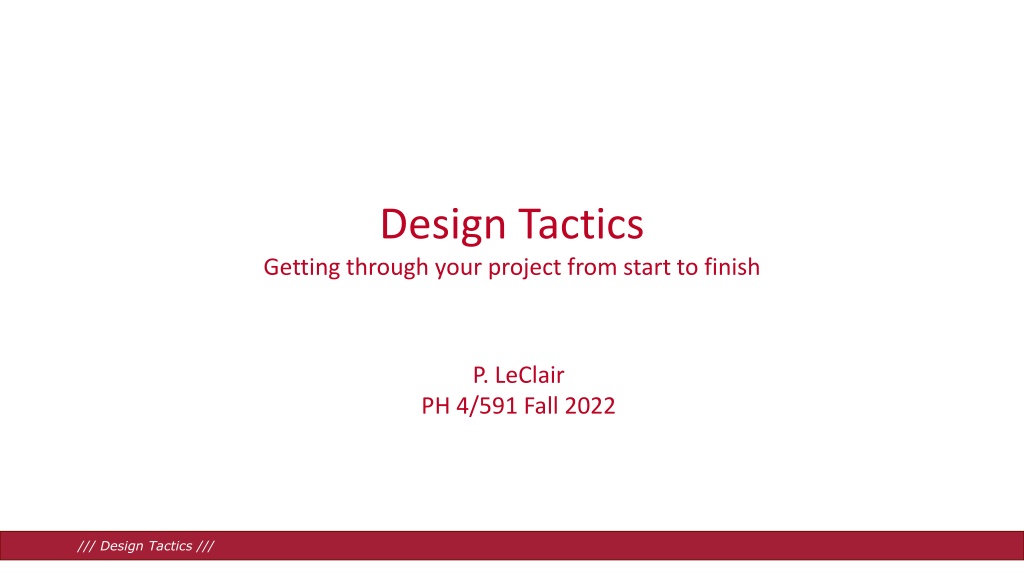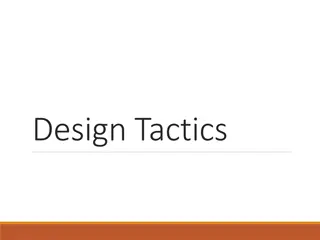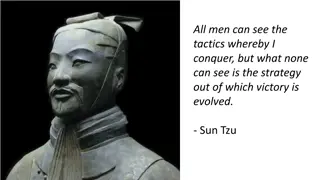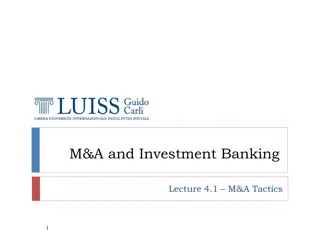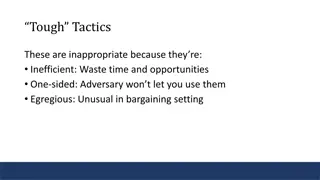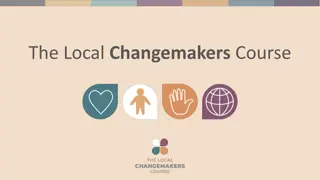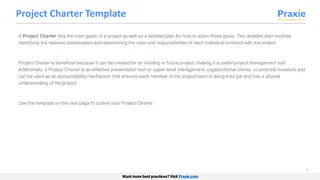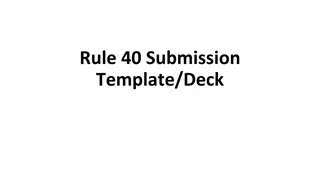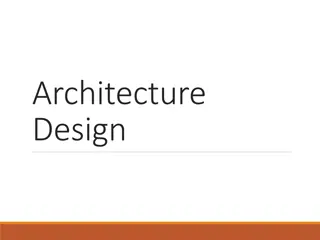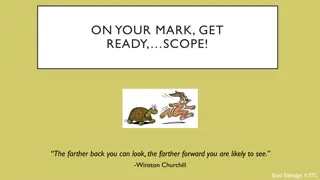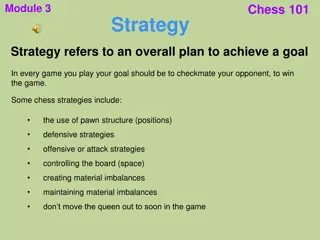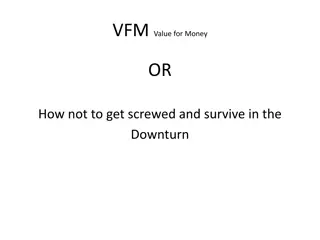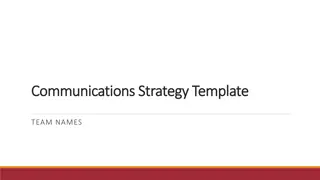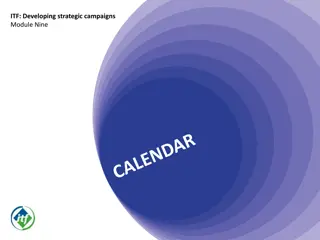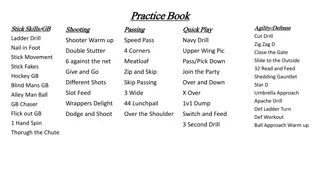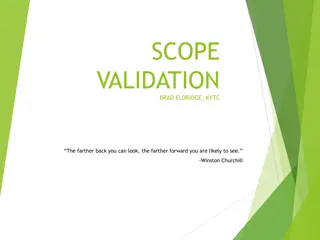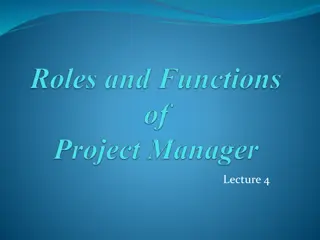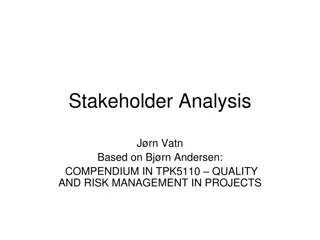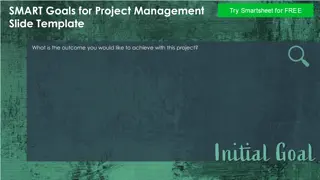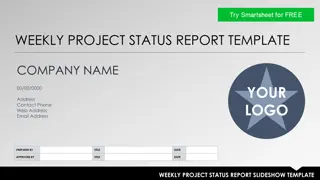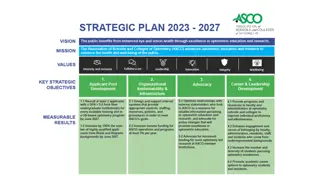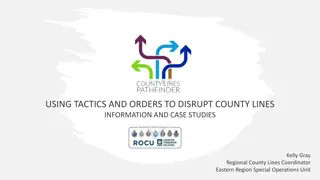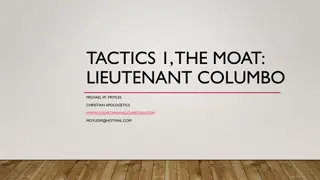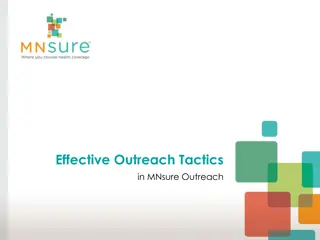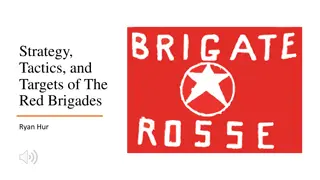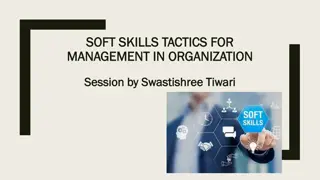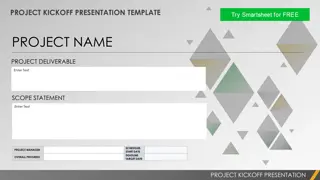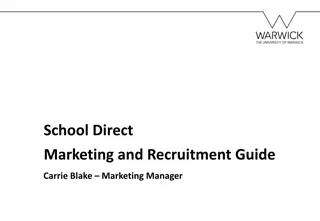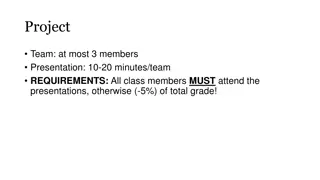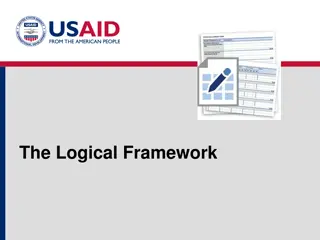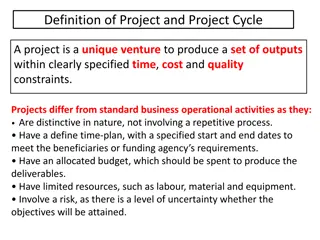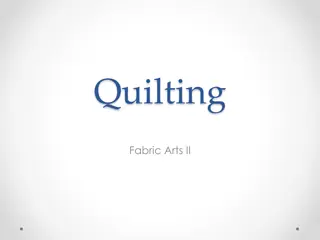Mastering Design Tactics: A Comprehensive Guide for Project Success
Delve into the world of design tactics and learn how to navigate your project from start to finish effectively. Explore concepts like the scientific method, forming hypotheses, selecting appropriate processes, working in teams, and communicating results. Discover the tools, processes, and strategies essential for successful project execution in a collaborative environment.
Download Presentation

Please find below an Image/Link to download the presentation.
The content on the website is provided AS IS for your information and personal use only. It may not be sold, licensed, or shared on other websites without obtaining consent from the author. Download presentation by click this link. If you encounter any issues during the download, it is possible that the publisher has removed the file from their server.
E N D
Presentation Transcript
Design Tactics Getting through your project from start to finish P. LeClair PH 4/591 Fall 2022 /// Design Tactics ///
A starting point The Scientific Method - an iterative process by which we try to construct laws of nature. If the prediction is inaccurate, you modify the hypothesis If the predictions prove to be accurate test after test it is elevated to the status of a law or a theory. /// Design Tactics ///
Models ftw forming a hypothesis almost always involves developing a model a model is a simplified conceptual representation of some phenomenon. But you know this How do you actually do stuff? /// Design Tactics ///
Models and Methods Abstract the requirements to get to crux of the problem and essential characteristics Emphasize selection of appropriate processes and techniques Step-by-step from qualitative to quantitative Deliberate variation and combination of solution elements of different complexity /// Design Tactics ///
OK, you have an idea. Now what? Properly defining the problem? The solution? How design your experiment or project? How do you figure out how to execute the plan? How do you work in a team to solve it? How to communicate your results? Buying $5 models with 50 data and other Panglossian problems. /// Design Tactics ///
Plan and Play Nice With Others The lone genius and flash of inspiration tropes were never true (ditto for ageism) You will have to work in a team This stuff is hard work It can t happen incoherently or without planning (if it could, someone already did it) There are Tools and Tactics that you can use There are Processes to guide you /// Design Tactics ///
Remember transferrable skills? Sounds a lot like engineering design? You re not wrong. It is a blurry (and uninteresting) line. It is all about doing something systematically, doing it well, and looking at what you are doing objectively. We aren t just fiddling with the knobs on the LHC or JWST after all. There are plans. /// Design Tactics ///
Try to relax Speaking of which: I didn t design this to be a high-pressure class If it is, let s figure out why /// Design Tactics ///
Activities, broadly Conceptualizing search for solution principles Embodying general arrangement and preliminary shape of materials and methods (aka: quick and dirty solution, proof of principle) Detailing finalizing details and making it go (now we are Professionals) Throughout computing, drawing, info gathering, iteration and feedback /// Design Tactics ///
Skills and activities These come up at various phases of the design & implementation of your research Decision making Project management Communication Collaboration Synergies among the skill areas /// Design Tactics ///
Decision making Sound and well-reasoned. Not gut feeling Systematically evaluate info & alternatives. Ensure clear rationale forms for each Establish criteria, eliminate biases. Data gathering, brainstorming, and testing Fit all this together systematic & iterative approach /// Design Tactics ///
Project management Focus on actual tasks & activities needed Working agreements Priorities Scheduling Record keeping Continuous quality improvement /// Design Tactics ///
Communication More than technical skills needed to succeed Must communicate your ideas Must communicate with a team Must listen Must remain calm and be willing to change your mind You must keep the team on the same page /// Design Tactics ///
Collaboration Again: the solitary genius narrative is a myth The great achievements you re thinking of were often based on teamwork and collaboration, or at least building on others work (or just straight stealing credit) This is a way of life for scientists & engineers, the problems are too big to tackle alone Also: a skill that needs to be learned /// Design Tactics ///
Synergies All these skill areas need to be applied together in an integrated way Make a working agreement (decision making, collaboration) Schedule tasks, assignments (proj. mgmt.) Plan when to meet (mgmt., collab., comm.) How to document it all (mgmt., comm.) /// Design Tactics ///
Other characteristics Iteration is key and fast enough! Keep iteration loops small for efficiency Stepwise, sequential vs concurrent Stepwise: each step waits on the prior one If it fails or requires revision: start over Concurrent: get the next step started ASAP As soon as possible or plausible perhaps Initial results may be enough to start modeling or designing next experiment, for example What can be done in parallel sensibly? What must be simultaneous or sequential? /// Design Tactics ///
Phases of design Usual steps, but process is iterative Constantly defining & redefining, changing gears 1: define the problem 2: formulate solutions 3: develop models and experiments 4: implementation and presentation Will come up throughout the course /// Design Tactics ///
Phases of design Phase 1: Define the Problem 1. Formulate problem statement 2. Identify functional requirements 3. Recognize constraints & limitations 4. Define schedule and form a team but go back as needed iteration is crucial Phase 2: Formulating Solutions 1. Identifying alternatives 2. Defining parameters 3. Evaluate & analyze alternatives 4. Select potential solution move on Phase 3: Models & Experiments 1. Select overall model 2. Analyze design 3. Preliminary tests 4. Revise, refine, critique Phase 4: Implement & Present 1. Implement missing experiments 2. Mockup presentation of whole 3. Follow up 4. Define the end /// Design Tactics ///
Yes, this is all a bit much We could just be screwing around in the lab. We re past the point of my pre-arranging everything to ensure it works out. But: if we don t start with some discipline and organization to our approach, we ll never add it later. We don't rise to the level of our expectations; we fall to the level of our training. Archilochus You do not rise to the level of your goals you fall to the level of your systems James Clear, Atomic Habits /// Design Tactics ///
Phase 1: defining the problem Why are you doing this? What has been done already? literature What is the hypothesis? What are the consequences of it? Testable? What do you hope to learn? What constraints are present? Physical vs technical vs economic, etc /// Design Tactics ///
Phase 1: defining the problem 3 basic components of a problem An undesirable initial state A desirable goal state Obstacles that prevent moving from initial to goal state at a particular point in time Obstacles: Means to overcome unknown and must be found Mean are known but super complicated systematic investigation not possible Goals are vague or not formulated clearly must remove conflicts until they are /// Design Tactics ///
Phase 1: defining the problem Problems also have complexity and uncertainty /// Design Tactics ///
Phase 1: defining the problem Balance of being open-ended enough to not preclude cool ideas but well-defined enough to be actionable. Your first attempts will be open-ended and loosely structured. That s fine. Define in a way others can understand You will be part of a team /// Design Tactics ///
Phase 1: defining the problem Background research: you must know what has been done already Read the literature, keep an open mind Find experts to talk to when you can Place your work in context Avoid duplicating, but with an eye toward replicating earlier results as a starting point /// Design Tactics ///
Phase 1: defining the problem Eliminating biases and overcoming assumptions Relying solely on literature is also not good Mistakes and biases propagate. Think it through. Are you only using the familiar tools? Are you limiting or biasing yourself? Working within a team can help It doesn t mean reinventing the wheel, but keep asking why, and why again /// Design Tactics ///
Phase 1: defining the problem What is the actual problem requires placing it in broader context Example: rare-earth-free permanent magnets On the surface: hard-to-mine materials, etc But also: sticky political problem coupled with horrifically dirty mining processes The actual problem is only partly scientific Meaning: moving target! Example: parking downtown. Not an engineering problem! /// Design Tactics ///
Phase 1: defining the problem Identifying functional requirements Must be a need, or an open question Must be one you & your team can address Recognize constraints & limitations what and how are shaped by but and however we can t actually get the LHC to do our experiment, what can we learn from what they ve already done? /// Design Tactics ///
Phase 1: defining the problem Objective tree: Planck-LED experiment (PH255) Planck-LED LEDs spectrometer software I(V) hardware visible emission transparent housing accessible leads control V, measure V & I ~350-800nm? low intensity save data plot data variety of colors V source I meter V meter 0-5V 0-10mA PC control PC read 0-5V PC read 0-10mA /// Design Tactics ///
Phase 1: defining the problem Sketches are key. Label and date them. Clarify the problem over time; may involve going back to the basic problem statement Define a schedule and form a team Regular meeting times/formats/locations Coordinate your schedules, give & take Schedule of ordered activities & reviews Always give a cushion /// Design Tactics ///
Phase 1: defining the problem Keep track of stuff. E.g., shared files on Box. Modify as you go. Change roles as needed. Particularly if no one is obviously in charge! /// Design Tactics ///
Phase 1: defining the problem Working as a team is by far the hardest part. Look to your left, look to your right. One of those people is going to disappoint you soon. Hahaha. No really. Just be open with each other and learn to compromise. It will be fine. /// Design Tactics ///
Phase 1: defining the problem You will need to meet. Establish specific times, start and end and places Can agree to start each class with a short planning meeting Have a plan for the meeting. Why are you there? Have an end goal we will finish X If you can t do the last two, don t meet Learn to prioritize. 50% finished always beats 0% finished Perfect is the enemy of good /// Design Tactics ///
Phase 1: defining the problem Leave the meeting knowing when you meet next and why Set a working agreement for the meantime Set channels of communication Be patient with each other, stuff happens. /// Design Tactics ///
Phase 2: formulating solutions Systematically explore & evaluate alternatives Usually more than one solution What are the tradeoffs? Options & constraints. Solving one aspect may confound another Right now, or soon? Who do you need on your team? What techniques are you going to need? /// Design Tactics ///
Phase 2: formulating solutions Your longer experiments will be like this You will be given a starting point and must design the path forward Some paths are objectively better than others But some less-ideal paths are more reasonable than others, you will have to compromise /// Design Tactics ///
Phase 2: formulating solutions Decision-making behaviors Recognize dependencies Estimate importance and urgency Persistence and flexibility Failures cannot be avoided Define goals, clarify boundary conditions. Search for variants, evaluate on merits. Decide! /// Design Tactics ///
Phase 2: formulating solutions /// Design Tactics ///
Phase 2: formulating solutions What is a Gantt chart? A fancy schedule. You will see them again. Keys: Identify tasks Identify time sequence Estimated task duration /// Design Tactics ///
Phase 2: formulating solutions An example from a proposal. Easy to make in a spreadsheet Figure 5: AI-augmented-Rx activities and timeline /// Design Tactics ///
Phase 2: formulating solutions Conflict in your group is normal. Keep in mind this is just a class It is too early for it yet, hopefully So, I ll leave a few things at the end for later Note deliverable 1 is a work plan and team survey /// Design Tactics ///
Phase 3: models & experiments Translate ideas into practice Hands-on phase! Prototypes! Sub-functions that were black boxes must now be concrete As results and analysis come in Revise alternatives. Refine or reevaluate problem? The first experiment always goes wrong but it is only a failure if you fail to learn from it /// Design Tactics ///
Choose: Heuristic? Slater-Pauling Phase 3: models & experiments Quick? synthesis? plausible? Log? in? database? for? others? to? evaluate No DFT (XYZ? half? Heusler as? C1b) (X2YZ? full? Heusler as? L21) Yes Bulk? synthesis Example: materials discovery Develop algorithm for work Plenty of start over steps! No Stable? Revise? heuristic? rules No Revise? feasibility? assessment Single? phase? Yes Log? in? database? for? others? to? evaluate No Magnetic? Half? metal? Yes Structure,? composition,? magnetism,? etc. Yes Check? in? OQMD Refine? theory (e.g.,? cluster? expansion,? S-O,? U) Agree? with? theory? No Yes Phase? decomp.? Yes Revise? heuristic? rules Log? in? database? for? others? to? evaluate Useful? properties? for? us? No No Assess? feasibility? of? synthesis Yes Thin? film? growth,? advanced? characterization? /// Design Tactics ///
Phase 3: models & experiments Example: Fe-V-Ge alloy system At first nothing was stable Revisions based on data charted a path forward Led to a nice bit of work The real key was to forget what we were looking for and focus on what was in front of us /// Design Tactics ///
Fe(3-x)VxGe System Fe2.5V0.5Ge (5D,7D &14D at 950C) (Cubic & 0.032% V rich dots) Fe2VGe (7D 900C, 7D 1000C & 7D 850C) Fe1.5VGe Fe2.15V0.85Ge( 7D 950C & 15D 900C) Fe2.375V0.625Ge (7D 950) (Cubic & 0.954% V rich dots) Fe2.20V0.80Ge (7D 950C ) Fe1.5VGe Fe2.625V0.375Ge (7D 950C) (Cubic & 0.028% V rich dots) Fe2.75V0.25Ge (7D 950C) (Hexagonal & 5.110% 2nd phase) Fe1.5VGe (7D 950C) Fe2.25V0.75Ge (5D &14D 950C) ( Cubic & 5.657% 2nd phase) Fe2.875V0.125Ge (7D 950C) (0.899% 2nd phase) /// Design Tactics ///
Phase 3: models & experiments /// Design Tactics ///
Phase 3: models & experiments Predictive models: theory leads Scale models: try a simpler/smaller version Quick & dirty: proof of principle, with understanding it must be redone if successful Simulation: e.g., finite element /// Design Tactics ///
Phase 3: models & experiments Design analysis: driven by preliminary data What happened? Did it match expectations? If not, do you know why? If you don t know why, what to test/check? Is a redesign necessary? Was it good enough? Where are improvements needed or desired? In all stages: prioritize! /// Design Tactics ///
Phase 3: models & experiments Clarifying roles & responsibilities Do you know who is doing what? Is it better to have 1 or multiple people on a task? Who works well together? Which skills are needed and who has them? If the answer is no one who are you gonna call? /// Design Tactics ///
Phase 3: models & experiments Obtaining resources: I control or negotiate the resources, mostly Make a good case for what you need Justifylogically, cost effectiveness, utility ROI Progress reports: Keep the above in mind If you want more stuff, indicate you use current stuff well. /// Design Tactics ///
